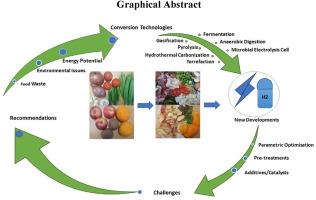A comprehensive review of advancements and challenges in hydrogen production from thermochemical and biological conversion of food waste: The path forward
IF 8.3
2区 工程技术
Q1 CHEMISTRY, PHYSICAL
引用次数: 0
Abstract
The environmental impact of food waste, estimated at approximately 1.3 billion tons per year globally, is alarming and requires urgent attention. Similarly, with energy demand expected to rise to approximately 568 Mt of H2 by 2050, there is a growing appeal within the scientific community to develop alternatives to fossil fuels, which are major contributors to global warming. Hence, significant efforts are being directed towards advancing current food waste conversion technologies and exploring novel approaches that could potentially replace the less efficient methods in the near future. The current review aims to provide state-of-the-art developments and upgrades in thermochemical (pyrolysis, gasification, intermediate processes such as torrefaction, and hydrothermal carbonization) and biological (fermentation) conversion technologies supporting hydrogen production from different food wastes. Notably, household food waste has shown more potential compared with synthetic factory prepared sources. The influence of different operating parameters, pre-treatments, and additives or catalysts supporting food waste conversion to hydrogen are mentioned. This review indicates that hydrothermal carbonization and torrefaction show promise in producing intermediate products, which can then be further processed through pyrolysis and gasification to generate energy. Gasification is found to be more promising and mature technique than pyrolysis and fermentation. This review also highlights the challenges encountered in these technologies and provides a way forward for future research and developments. Moreover, the conclusive remarks are provided for this review.

从食物垃圾的热化学和生物转化制氢的进展和挑战的综合综述:前进的道路
据估计,全球每年食物浪费对环境的影响约为13亿吨,令人震惊,需要紧急关注。同样,到2050年,预计能源需求将增加到约5.68亿吨氢气,科学界越来越呼吁开发化石燃料的替代品,化石燃料是导致全球变暖的主要原因。因此,人们正在努力推进目前的食物垃圾转化技术,并探索可能在不久的将来取代效率较低的方法的新方法。本综述旨在提供热化学(热解、气化、中间过程如焙烧和水热碳化)和生物(发酵)转化技术的最新发展和升级,支持从不同的食物垃圾中制氢。值得注意的是,与工厂合成的食物垃圾相比,家庭食物垃圾显示出更大的潜力。讨论了不同的操作参数、预处理方法、助剂或催化剂对厨余制氢的影响。这一综述表明,水热碳化和焙烧有希望生产中间产品,然后通过热解和气化进一步加工产生能量。与热解和发酵相比,气化是一种更有前途和成熟的技术。这篇综述还强调了这些技术中遇到的挑战,并为未来的研究和发展提供了一条前进的道路。此外,还对本次审查提出了结论性意见。
本文章由计算机程序翻译,如有差异,请以英文原文为准。
求助全文
约1分钟内获得全文
求助全文
来源期刊

International Journal of Hydrogen Energy
工程技术-环境科学
CiteScore
13.50
自引率
25.00%
发文量
3502
审稿时长
60 days
期刊介绍:
The objective of the International Journal of Hydrogen Energy is to facilitate the exchange of new ideas, technological advancements, and research findings in the field of Hydrogen Energy among scientists and engineers worldwide. This journal showcases original research, both analytical and experimental, covering various aspects of Hydrogen Energy. These include production, storage, transmission, utilization, enabling technologies, environmental impact, economic considerations, and global perspectives on hydrogen and its carriers such as NH3, CH4, alcohols, etc.
The utilization aspect encompasses various methods such as thermochemical (combustion), photochemical, electrochemical (fuel cells), and nuclear conversion of hydrogen, hydrogen isotopes, and hydrogen carriers into thermal, mechanical, and electrical energies. The applications of these energies can be found in transportation (including aerospace), industrial, commercial, and residential sectors.
 求助内容:
求助内容: 应助结果提醒方式:
应助结果提醒方式:


